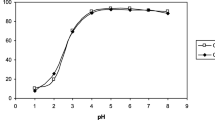Abstract
The sorption of ultra-trace levels of polonium by Luffa Cylindrica biochar fibers has been investigated in de-ionized water and seawater samples prior and after surface modification (Ag-coating) of the adsorbent. The effect of pH on the sorption efficiency (e.g., partition coefficient values, Kd) indicated that pH, which governs the solution chemistry of Po(IV), affects to a large degree the sorption efficiency and that Ag-coating of the surface results in significantly higher Kd values. The modified adsorbent presents enhanced removal efficiency for Po-209 even from seawater samples indicating the usefulness of the modified biochar fibers for the treatment of polonium contaminated waters.



Similar content being viewed by others
References
Carvalho FP, Fernandes S, Fesenko S, Holm E, Howard B, Martin P, Pröhl G, Twinig (2017) The Environmental Behaviour of Polonium. IAEA Tec Rep Ser No484 7:276
Ansoborlo E, Berard P, Den Auwer C, Leggett R, Menetrier F, Younes A, Moisy P (2012) Review of chemical and radiotoxicological properties of polonium for internal contamination purposes. Chem Res Toxicol 25:1551–1564
Strumińska-Parulska D, Skwarzec B, Tuszkowska A, Jahnz-Bielawska A, Boryło A (2010) Polonium (210 Po), uranium (238 U) and plutonium (239 + 240 Pu) in the biggest Polish rivers. J Radioanal Nucl Chem 286:373–380
Hicsonmez U, Erenturk SA, Gorgun AU, Aslani MAA (2020) Removal of 209Po from aquatic environment and its equilibrium and thermodynamic parameters. J Environ Radioact 220:106280
Seiler R (2016) 210Po in drinking water, its potential health effects, and inadequacy of the gross alpha activity MCL. Sci Total Environ 568:1010–1017
Hossain F (2020) Natural and anthropogenic radionuclides in water and wastewater: Sources, treatments and recoveries. J Environ Radioact 225:106423
MacKenzie AB, Scott RD (1979) Separation of bismuth-210 and polonium-210 from aqueous solutions by spontaneous adsorption on copper foils. Analyst 104(1245):1151–1158
El Afifi EM, Borai EH (2006) Performance Characteristics of Sequential Separation and Quantification of Lead-210 and Polonium‐210 by Ion Exchange Chromatography and Nuclear Spectrometric Measurements. J Enviro Qual 35(2):568–574
Lemons B, Khaing H, Ward A, Thakur P (2018) A rapid method for the sequential separation of polonium, plutonium, americium and uranium in drinking water. Appl Radiat Isot 136:10–17
Suganuma H, Ito K, Hataye I (1981) Separation of polonium species in nitrate solutions by paper chromatography. J Radioanal Chem 62(1–2):125–133
Liatsou I, Christodoulou E, Pashalidis I (2018) Thorium adsorption by oxidized biochar fibres derived from Luffa cylindrica sponges. J Radioanal Nucl Chem 317:1065–1070
Sawai O, Oshima Y (2008) Deposition of silver nano-particles on activated carbon using supercritical water. J Supercrit Fluids 47:240–246
Kiliari T, Pashalidis I (2010) Simplified alpha-spectroscopic analysis of uranium in natural waters after its separation by cation-exchange. Radiat Meas 45:966–968
Prodromou M, Pashalidis I (2013) Radium removal from aqueous solutions by adsorption on non-treated and chemically modified biomass by-product. J Radioanal Nucl Chem 295:2095–2102
Ioannidis I, Anastopoulos I, Pashalidis I (2022) Microplastics as radionuclide (U-232) carriers. J Mol Liq 351:118641
Ram R, Vaughan J, Etschmann B, Brugger J (2019) The aqueous chemistry of polonium (Po) in environmental and anthropogenic processes. J Hazard Mater 380:120725
Karali T, Ölmez S, Yener G (1996) Study of spontaneous deposition of 210Po on various metals and application for activity assessment in cigarette smoke. Appl Radiat Isot 47:409–411
Sethy NK, Sutar AK, Rath P, Jha VN, Ravi PM, Tripathi RM (2015) A review of radio chemical analysis and estimation of 210Po in soil matrices. J Radiat Res Appl 8:590–596
Carvalho F, Fernandes S, Fesenko S, Holm E, Howard B, Martin P, Twining J (2017) The environmental behaviour of polonium IAEA
Serne RJ (2007) Kd values for agricultural and surface soils for use in Hanford site farm, residential, and river shoreline scenarios. PNNL (No. PNNL-16531)
Hadjittofi L, Prodromou M, Pashalidis I (2014) Activated biochar derived from cactus fibres – Preparation, characterization and application on Cu(II) removal from aqueous solutions. Bioresour Technol 159:460–464
Liatsou I, Pashalidis I, Oezaslan M, Dosche C (2017) Surface Characterization of Oxidized Biochar Fibers Derived from Luffa Cylindrica and Lanthanide Binding. J Environ Chem Eng 5:4069–4074
Author information
Authors and Affiliations
Corresponding author
Additional information
Publisher’s Note
Springer Nature remains neutral with regard to jurisdictional claims in published maps and institutional affiliations.
Rights and permissions
Springer Nature or its licensor holds exclusive rights to this article under a publishing agreement with the author(s) or other rightsholder(s); author self-archiving of the accepted manuscript version of this article is solely governed by the terms of such publishing agreement and applicable law.
About this article
Cite this article
Philippou, M., Pashalidis, I. Polonium removal from waters by silver-coated Luffa Cylindrica biochar fibers. J Radioanal Nucl Chem 332, 1395–1398 (2023). https://doi.org/10.1007/s10967-022-08607-4
Received:
Accepted:
Published:
Issue Date:
DOI: https://doi.org/10.1007/s10967-022-08607-4




